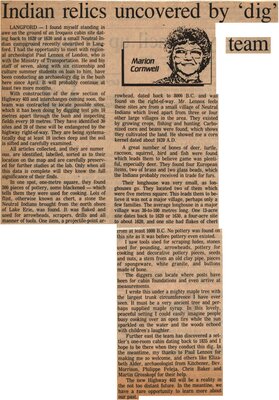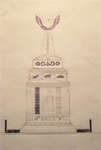"Indian Relics Uncovered by 'Dig' Team"
- Full Text
- Indian relics uncovered by 'dig' team
LANGFORD - I found myself standing in awe on the ground of an Iroquois cabin site dating back to 1620 or 1630 and a small Neutral Indian campground recently unearthed in Langford. I had the opportunity to meet with regional archeologist Paul Lennox of London, who is with the Ministry of Transportation. He and his staff of seven, along with six citizenship and culture summer students on loan to him, have been conducting an archaeology dig in the bush here since April. It will continue at least two more months.
With construction of the new section of Highway 403 and interchanges coming soon, the team was contracted to locate possible sites, which it has been doing by digging test pits 10 metres apart through the bush and inspecting fields every 10 metres. They have identified 30 sites and 20 of these will be endangered by the highway right-of-way. They are being systematically dug at least 10 inches deep and the soil is sifted and carefully examined.
All articles collected, and they are numerous, are identified, labelled, sorted as to their location on the map and are carefully preserved for further studies at the lab. Only when all this data is complete will they know the full significance of their finds.
In one spot, one-metre square, they found 300 pieces of pottery, some blackened - which tells them they were used for cooking. Lots of flint, otherwise known as chert, a stone the Neutral Indians brought from the north shore of Lake Erie, was found. It was flaked and used for arrowheads, scrapers, drills and all manner of tools. One item, a projectile-point arrowhead, dated back to 8000 B.C. and was found on the right-of-way. Mr. Lennox feels these sites are from a small village of Neutral Indians which lived apart from three or four other large villages in the area. They existed by growing crops, fishing and hunting. Carbonized corn and beans were found, which shows they cultivated the land. He showed me a corn kernel dated about 1620 A.D.
A great number of bones of deer, turtle, raccoon, squirrel, bird and fish were found which leads them to believe game was plentiful, especially deer. They found four European items, two of brass and two glass beads, which the Indians probably received in trade for furs.
Their longhouse was very small, as longhouses go. They located two of them which were five metres square. This leads them to believe it was not a major village, perhaps only a few families. The average longhouse in a major village was 30-to-100 metres long. One 13-acre site dates back to 1620 or 1630, a four-acre site to about 1620, and one site had flakes of chert from at least 1000 B.C. No pottery was found on this site as it was before pottery even existed.
I saw tools used for scraping hides, stones used for pounding, arrowheads, pottery for cooking and decorative pottery pieces, seeds and nuts, a stem from an old clay pipe, pieces of spongeware, white granite, and buttons made of bone.
The diggers can locate where posts have been for cabin foundations and even arrive at measurements.
I wrote this under a mighty maple tree with the largest trunk circumference I have ever seen. It must be a very ancient tree and perhaps supplied maple syrup. In this lovely, peaceful setting I could easily imagine people busy cooking over an open fire while the sun sparkled on the water and the woods echoed with children's laughter.
Further east the team has discovered a settler's one-room cabin dating back to 1835 and I hope to be there when they conduct this dig. In the meantime, my thanks to Paul Lennox for making me so welcome, and others like Elizabeth Alder, archaeologist from Kitchener, Bev. Morrison, Phillippe Peleja, Chris Baker and Martin Grosskopf for their help.
The new Highway 403 will be a reality in the not too distant future. In the meantime, we have a rare opportunity to learn more about our past.
- Creator
- Cornwell, Marion, Author
- Media Type
- Newspaper
- Item Types
- Articles
- Clippings
- Description
- "I found myself standing in awe on the ground of an Iroquois cabin site dating back to 1620 or 1630 and a small Neutral Indian campground recently unearthed in Langford. I had the opportunity to meet with regional archeologist Paul Lennox of London, who is with the Ministry of Transportation. He and his staff of seven, along with six citizenship and culture summer students on loan to him, have been conducting an archeology dig in the bush here since April. It will probably continue at least two more months."
- Date of Publication
- 1989
- Subject(s)
- Personal Name(s)
- Lennox, Paul ; Alder, Elizabeth ; Morrison, Bev ; Peleja, Philippe ; Baker, Chris ; Grosskopf, Martin.
- Corporate Name(s)
- Ministry of Transportation.
- Local identifier
- SNPL002507v00d
- Collection
- Scrapbook #1 by Janet Heaslip
- Language of Item
- English
- Geographic Coverage
-
-
Ontario, Canada
Latitude: 43.1668 Longitude: -80.13295
-
- Creative Commons licence
 [more details]
[more details]- Copyright Statement
- Public domain: Copyright has expired according to Canadian law. No restrictions on use.
- Copyright Date
- 1989
- Contact
- Six Nations Public LibraryEmail:info@snpl.ca
Website:
Agency street/mail address:1679 Chiefswood Rd
PO Box 149
Ohsweken, ON N0A 1M0
519-445-2954




